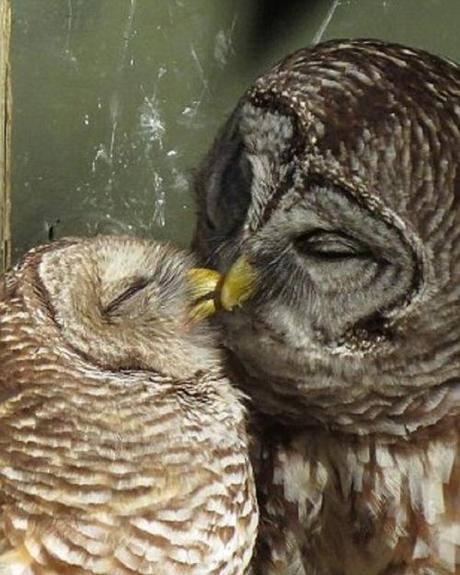Tyto alba

The Barn Owl is a pale, long-winged, long-legged owl with a short squarish tail. Generally a medium-sized owl, there is considerable size variation across its subspecies, from 9.8 to 19.7 inches in overall length, with a wingspan of 30 to 43 in, with a body mass from 6.6 to 28.2 oz.
The Barn Owl’s light-colored heart-shaped face and black eyes give the flying bird an odd and startling appearance. The ridge of feathers above the bill somewhat resembles a nose. Nestlings are covered in white down all over, but the heart-shaped facial disk is visible soon after hatching.
Contrary to popular belief, the Barn Owl does not hoot (such calls are made by typical owls, like the Tawny Owl). It instead produces the characteristic shree scream, ear-shattering at close range. Males in courtship give a shrill twitter. The Barn Owl can hiss like a snake to scare away intruders, and when captured or cornered, it throws itself on its back and flails with sharp-taloned feet, making for an effective defense.
Like other owls, the Barn Owl is nocturnal, but often becomes active shortly before dusk and can sometimes be seen during the day when relocating from a sleeping place it does not like.
This is a bird of open country such as farmland or grassland with some interspersed woodland. Like most owls, the Barn Owl flies silently; tiny serrations on the leading edges of its flight feathers help to break up the flow of air over its wings, thereby reducing turbulence and the noise that accompanies it.
It hunts by flying low and slowly over an area of open ground, hovering over spots that conceal potential prey. They may also use fence posts or other lookouts to ambush prey. The Barn Owl primarily feeds on small vertebrates, particularly rodents. Studies have shown that an individual Barn Owl may eat one or more rodents per night; a nesting pair and their young can eat more than 1,000 rodents per year.
The Barn Owl has acute hearing, with ears placed asymmetrically for improved detection of sound position and distance, and it does not require sight to hunt. Hunting nocturnally, it can target and dive down, penetrating its talons through snow, grass or brush to seize rodents with deadly accuracy. Compared to other owls of similar size, the Barn Owl has a much higher metabolic rate, requiring relatively more food. Pound for pound, Barn Owls consume more rodents—often regarded as pests by humans—than possibly any other creature. This makes the Barn Owl one of the most economically valuable wildlife animals to farmers. Farmers often find these owls more effective than poison in keeping down rodent pests, and they can encourage Barn Owl habitation by providing nest sites.
In temperate regions, the breeding season usually starts in late March to early April. Breeding can take place at any time prey is abundant, and in the warm parts of its range may occur at any time of the year. The female typically lays 4 to 7 eggs. The male brings food to the nest as the female incubates the eggs and cares for chicks.
Sadly, most Barn Owls manage to breed only once in their life, falling victim to predators or accidents before being two years of age. Only one young in three manages to live to its first breeding attempt. But captive Barn Owls may reach 20 years of age or more. The American record age for a wild Barn Owl was 11½ years; a Dutch owl lived almost 18 years.
Predators of the Barn Owl include mammals such as the large American opossums (Didelphis) and the Common Raccoon (Procyon lotor); large snakes; and large raptors such as hawks, eagles, and owls such as the Great Horned Owl (Bubo virginianus) and the Eurasian Eagle-owl (B. bubo). But the biggest threat are humans and their pets, in particular house or feral cats.
~Eowyn

